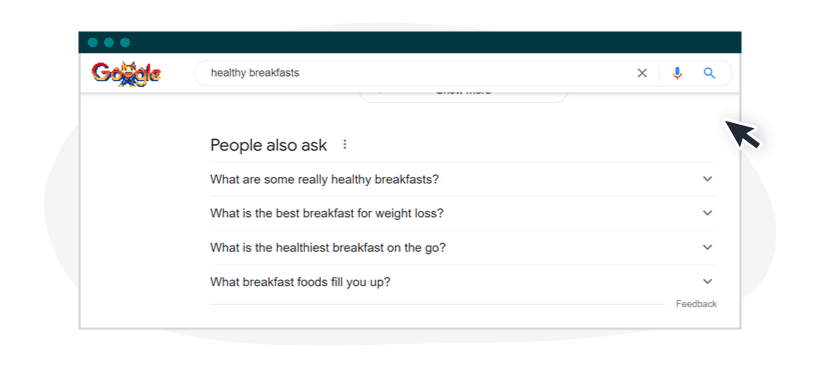Even the most experienced marketers aren’t immune to the occasional misstep, and in the fast-paced world of content marketing, those slip-ups can have significant consequences. Mistakes can tarnish a brand’s reputation, alienate audiences, or even impact the bottom line. Navigating the complex landscape of content creation and distribution is no small task, and with so much at stake, it’s crucial to get it right.
As you refine your content strategy, be aware of these five common content marketing mistakes to ensure your efforts strengthen, rather than compromise, your brand’s standing.
1. Always Selling Yourself With Your Content
In content marketing, brands often focus too much on themselves and not enough on their audience.
Let’s say you sell Puffleberry brand healthy breakfast products. Your target audience is searching for recipes, answers to their questions about healthy eating, and advice for eating breakfast on the go and/or weight loss.
Now, if all your content does is promote Puffleberry brand products, a few things are likely to happen:
- You won’t show up very high in the SERPs. Google likes in-depth content that meets a searcher’s intent; if all you’re doing is publishing 200-word posts announcing Puffleberry’s latest offering, don’t expect to rank well in search.
- When users who weren’t searching for branded terms do happen to land on your site, they’ll bounce quicker.
- You miss an untold number of opportunities to engage new users, increase email signups, establish yourself as a leader in the food industry, earn backlinks naturally, get social shares — all because your content is Puffleberry-focused and not audience-focused.
There’s a rule that’s been floating around content marketing circles for almost 20 years that says 80 percent of your content should be audience-focused and 20 percent should be brand-focused. There’s no science to that ratio, and your content creation efforts don’t have to be divided exactly 80/20.
The main point is that the bulk of your content should focus on your audience, answering their questions, anticipating their needs, and occasionally making them smile or tug at their hearts. Then, you can talk about yourself.
2. Not Doing Video
In its annual report on video marketing statistics for 2024, video production company Wyzowl reveals these important stats:
- 91 percent of businesses use video as a marketing tool — an all-time high since they started tracking this data in 2016.
- 88 percent of video marketers see video as an important part of their overall strategy.
- Of those marketers who did not use video at the time of the survey, 68 percent said they plan to start using video in 2024.
Are you among the 9 percent who aren’t using video? In this group, the most common reason we hear for this is that they lack the in-house talent to develop video, but the costs of hiring an external production company are beyond budget.
We get it. We’ve even been there. Our advice? Shoot on a smartphone. Once you make the initial investment in the following equipment, you’ll be able to make professional-quality videos relatively quickly and inexpensively:
- Lighting (such as a selfie ring light or clip-on light)
- Tripod
- Stabilizer
- Lens
- Microphone
- Editing software
Make sure to create a video marketing strategy first. Then, maximize the ROI of your content by repurposing videos across different platforms and formats. For example, you can use shorter clips for social media, blog posts or email.
3. Relying Too Heavily on Keyword Research
Let’s face it: Keyword data isn’t always accurate, and there is no end-to-end MarTech platform that integrates keyword data with the rest of the marketing stack. It’s a controversial stance, but some content marketers go so far as to say that keyword data no longer matters. While we won’t go quite that far, we can tell you not to live and die by it.
The most important factor is to simply be a reputable site, according to Google Search Essentials. Create content that is useful, trustworthy, authoritative, and meets the needs of your clients, and Google will naturally begin to view you as an authority in your field.
This isn’t to say you should abandon your SEO tools altogether. Just make sure you’re leveraging all the beneficial features available with them.
SEO Tools to Consider
- Not only is Moz an excellent tool for keyword research, but it also has one of the best competitor tracking features out there. When the tool checks your keyword rankings, it also does so for three of your competitors. Seeing your competitors’ search query ranking data — which you can’t do via Google or Bing Webmaster Tools — is a huge benefit. You can also use Moz to track your competitors’ backlinks as well as your own.
- Semrush offers a ton of data for each term, including search volume trends and number of results, but its breadth of services in its premium plans is what makes it such a strong tool. It offers unique add-ons such as heat maps to see how users interact with your site pages, reputation management data and tools, and even a “lead finder” tool for marketing agencies.
- AnswerThePublic can’t beat the above two tools for keyword data, but it is a fun tool to visualize related keywords. It reports related search inquiries to your keywords. In the image below, you’ll see what the keyword map for “healthy breakfasts” looks like. In some cases, you’ll see an almost endless supply of content ideas related to your topic. AnswerThePublic lets you export the list of keywords in a spreadsheet for free, too.
And, of course, there’s Google’s keyword planner tool. One of our favorite keyword-friendly ideation tricks is to use Google’s autofill search function to see which keyword phrases people search for. Using our “healthy breakfasts” example, this is what Google Suggest says:
Google just gave you five ideas for blog content on topics that we know are highly searched for (or Google wouldn’t have suggested them).
You’ve researched your content, optimized it with the right keywords, and published it on your website. Now what? What do you want your readers to do next? And how are you going to help them find that content? Those are our last two tips: using calls to action and amplifying your content through other channels.
4. Not A/B Testing Your CTAs
Every piece of content should have an exit door that leads to a conversion point. Strong CTAs are important — but are you A/B testing them, too?
That might be the most important part. If you’re not A/B testing to measure the impact of changes to a CTA (such as color, size, text, or placement), how do you know which designs and words resonate with your audience and which ones don’t? You can use different metrics to evaluate your CTA, such as conversion rate, click-through rate, bounce rate, and time on page.
A/B testing can identify the CTA for each of your marketing campaigns that yields the highest conversion rate. Learn how to create an A/B test.
5. Amplifying Your Content Solely via Social
Amplification is also known as a content distribution strategy, or how you share your content across different channels.
Social media is excellent for this, but think of social media as a means to build your business, not the end goal. In other words, you don’t want to build an audience on Facebook, Twitter, Instagram, or Pinterest. When you build an audience on those social channels, you’re building an audience for Facebook, Twitter, Instagram, and Pinterest. You don’t own those audiences. You want to funnel that audience through those social channels to your website, where they can ask questions, subscribe to your newsletter, sign up for alerts, make appointments, and buy products. That’s your owned audience.
However, social channels do have value, and you can build an audience organically by sharing your content through these platforms. Just make sure to use these additional tactics to amplify your content:
- Partnering with influencers
- Paid campaigns
- Quoting experts (make sure to notify them that they’ve been mentioned in your article)
- Contributing to other publications
Content Marketing Solutions for Your Entire Funnel
Even the most seasoned professionals can find themselves facing unexpected challenges. As you’ve seen, common pitfalls such as focusing too heavily on self-promotion, neglecting video content, over-relying on keyword data, failing to optimize calls to action, and relying solely on social media for content amplification can significantly hinder your strategy’s effectiveness.
By steering clear of these mistakes, you can ensure that your content not only reaches but resonates with your audience, ultimately enhancing your brand’s reputation and contributing positively to your bottom line. Remember, the goal is to build a robust content strategy that supports your business objectives while engaging and expanding your audience. With these insights, you’re better equipped to refine your approach and achieve greater success in your content marketing efforts.
Need help getting started revamping your content strategy? Connect with a ClearVoice content strategist today.












